In every manufacturing business, there exists a “hidden factory.” It doesn’t appear on any floor plan, but it’s one of the most expensive parts of your operation. This hidden factory is the sum of all the time, materials, and labor spent on fixing mistakes. It’s the cost of scrap, rework, re-testing, and handling warranty claims. This entire expensive, wasteful operation is known by a single business metric: the Cost of Quality. Or, more accurately, the Cost of Poor Quality.
Counterintuitively, the best way to reduce this cost is to spend money in the right place. Investing in robust, automated testing products at the end of your production line is not an expense; it’s a strategic strike against the hidden factory. It’s a shift from paying for failure to investing in prevention and appraisal.
Understanding the Cost of Quality (CoQ)
The concept of Cost of Quality, a foundational principle in modern manufacturing, is broken down into four categories. As the American Society for Quality (ASQ) explains, these costs are divided into two main groups: the Cost of Good Quality (what you spend to do things right) and the Cost of Poor Quality (what you spend because you didn’t).
Cost of Good Quality (Investment):
- Prevention Costs: Money spent to prevent defects from happening in the first place (e.g., process improvements, training).
- Appraisal Costs: Money spent to find defects before products are shipped (e.g., inspections, testing). This is where automated testing lives.
Cost of Poor Quality (Expenses): 3. Internal Failure Costs: Costs of defects found before shipping (e.g., scrap material, labor for rework). 4. External Failure Costs: Costs of defects found after the customer receives the product (e.g., warranty repairs, product recalls, lawsuits, and lost reputation). This is the most dangerous and expensive category.
How Automated Testing Flips the Script
Without effective testing, the vast majority of your CoQ will be tied up in internal and, even worse, external failures. You are essentially paying to fix mistakes that have already been made.
By implementing an automated functional test system, you make a strategic investment in “Appraisal Costs.” This investment has a dramatic ripple effect that slashes the costs of failure.
- Drastically Reducing Internal Failures: An automated tester is a perfect gatekeeper. It catches every faulty unit before it gets boxed up, immediately preventing it from becoming expensive scrap or rework down the line. It identifies problems at the earliest, cheapest point.
- Virtually Eliminating External Failures: This is the biggest ROI. Every faulty product caught by the tester is one less product that fails in the field. This directly prevents the enormous costs associated with warranty claims, shipping replacements, and customer service time. More importantly, it protects your brand’s reputation, which is priceless.
- Providing Data for Prevention: This is the most advanced benefit. A modern automated test system doesn’t just give a pass/fail result; it logs detailed data on every test. By analyzing this data, engineers can spot trends. If a certain measurement is consistently drifting towards its failure limit, it can indicate a problem with an upstream component or process. This data turns your test system into a process improvement tool, allowing you to invest in “Prevention Costs” and stop defects before they even start.
Investing in automated test solutions is not about buying a machine; it’s about making a fundamental change to your business philosophy. It’s a strategic decision to stop funding your hidden factory and start investing in certainty. It’s one of the most powerful services you can provide to your bottom line.




